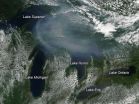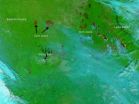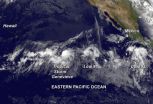(Press-News.org) Before the colonial era, 100,000s of people lived on the land now called California, and many of their cultures manipulated fire to control the availability of plants they used for food, fuel, tools, and ritual. Contemporary tribes continue to use fire to maintain desired habitat and natural resources.
Frank Lake, an ecologist with the U.S. Forest Service's Pacific Southwest Station, will lead a field trip to the Stone Lake National Wildfire Refuge during the Ecological Society of America's 99th Annual Meeting, in Sacramento, Cal. this August. Visitors will learn about plant and animal species of cultural importance to local tribes. Don Hankins, a faculty associate at California State University at Chico and a member of the Miwok people, will co-lead the trip, which will end with a visit to California State Indian Museum.
Lake will also host a special session on a "sense of place," sponsored by the Traditional Ecological Knowledge section of the Ecological Society, that will bring representatives of local tribes into the Annual Meeting to share their cultural and professional experiences working on tribal natural resources issues.
"The fascinating thing about the Sacramento Valley and the Miwok lands where we are taking the field trip is that it was a fire and flood system," said Lake. "To maintain the blue and valley oak, you need an anthropogenic fire system."
Lake, raised among the Yurok and Karuk tribes in the Klamath River area of northernmost California, began his career with an interest in fisheries, but soon realized he would need to understand fire to restore salmon. Fire exerts a powerful effect on ecosystems, including the quality and quantity of water available in watersheds, in part by reducing the density of vegetation.
"Those trees that have grown up since fire suppression are like straws sucking up the groundwater," Lake said.
The convergence of the Sacramento and San Joaquin rivers was historically one of the largest salmon bearing runs on the West Coast, Lake said, and the Miwok, Patwin and Yokut tribal peoples who lived in the area saw and understood how fire was involved.
California native cultures burned patches of forest in deliberate sequence to diversify the resources available within their region. The first year after a fire brought sprouts for forage and basketry. In 3 to 5 years, shrubs produced a wealth of berries. Mature trees remained for the acorn harvest, but burning also made way for the next generation of trees, to ensure a consistent future crop. Opening the landscape improved game and travel, and created sacred spaces.
"They were aware of the succession, so they staggered burns by 5 to 10 years to create mosaics of forest in different stages, which added a lot of diversity for a short proximity area of the same forest type," Lake said. "Complex tribal knowledge of that pattern across the landscape gave them access to different seral stages of soil and vegetation when tribes made their seasonal rounds."
In oak woodlands, burning killed mold and pests like the filbert weevil and filbert moth harbored by the duff and litter on the ground. People strategically burned in the fall, after the first rain, to hit a vulnerable time in the life cycle of the pests, and maximize the next acorn crop. Lake thinks that understanding tribal use of these forest environments has context for and relevance to contemporary management and restoration of endangered ecosystems and tribal cultures.
"Working closely with tribes, the government can meet its trust responsibility and have accountability to tribes, and also fulfill the public trust of protection of life, property, and resources," Lake said. "By aligning tribal values with public values you can get a win-win, reduce fire along wildlife-urban interfaces, and make landscapes more resilient."
INFORMATION:
Ecological Society of America's 99th Annual Meeting, August 10-15th, 2014, in Sacramento, Cal.
Main
Program
Press Information
App
FT 4: Tribal Land and Resource Management in the Sacramento Valley-Delta: Fire and Culture
Saturday, August 9, 2014: 9:00 AM-5:00 PM
Organizer: Frank K. Lake, U.S. Forest Service Pacific Southwest Research Station
Co-organizer: Don Hankins, California State University, Chico>
SS 10: Sense of Place
Monday, August 11, 2014: 10:15 AM-11:30 AM
Organizer: Frank K. Lake
Co-organizer: Ronald A. Trosper
Tribes represented include: Pomo, Coastal Miwok, Plains Miwok, and Miwok.
More fire ecology at the upcoming meeting: http://esa.org/am/info/press/topics/#fire
The Ecological Society of America is the world's largest community of professional ecologists and a trusted source of ecological knowledge. ESA is committed to advancing the understanding of life on Earth. The 10,000 member Society publishes five journals, convenes an annual scientific conference, and broadly shares ecological information through policy and media outreach and education initiatives. Visit the ESA website at http://www.esa.org.
Fire ecology manipulation by California native cultures
California's tribal peoples utilized wildfire to diversify resources
2014-07-25
ELSE PRESS RELEASES FROM THIS DATE:
Smoke from Canadian fires hover over Great Lakes
2014-07-25
Canadian wildfires have been raging this summer and some of the smoke from those fires is drifting downward into the U.S. In this image collected by the Moderate Resolution Imaging Spectroradiometer (MODIS) aboard the Aqua satellite on July 24, 2014 a swath of smoke has descended over the Great Lakes region of the United States. What is particularly interesting is the fire image from July 23, 2014 (first image feature highlighted below) clearly shows the path of the smoke as it drifts off southeastward. In the image, it is over Manitoba and parts of Ontario, and by ...
Slow walking speed and memory complaints can predict dementia
2014-07-25
July 25, 2014—(BRONX, NY)—A study involving nearly 27,000 older adults on five continents found that nearly 1 in 10 met criteria for pre-dementia based on a simple test that measures how fast people walk and whether they have cognitive complaints. People who tested positive for pre-dementia were twice as likely as others to develop dementia within 12 years. The study, led by scientists at Albert Einstein College of Medicine of Yeshiva University and Montefiore Medical Center, was published online on July 16, 2014 in Neurology®, the medical journal of the American Academy ...
Scalping can raise ticket prices
2014-07-25
Scalping gets a bad rap. For years, artists and concert promoters have stigmatized ticket resale as a practice that unfairly hurts their own sales and forces fans to pay exorbitant prices for tickets to sold-out concerts. But is that always true?
A new study by Victor Bennett, assistant professor of management and organization at the USC Marshall School of Business, along with colleagues at New York University and the Harvard Business School, finds that resale markets like Craigslist can add value to tickets sold by concert venues and Ticketmaster. "Cannibalization and ...
Burn scars in Eastern Russia
2014-07-25
The burn scars on this false-color image from the Terra satellite show the different areas that have been affected by this year's rash of wildfires in Eastern Russia. The burn scars show up as reddish-brown splotches of color against the green background. The wildfires have broken across the remote parts of Eastern Russia in the Sakha Republic. Even in this false-color image from the MODIS instrument, it is still possible to see the smoke rising from the fires that continue. Two recent image features noted below show the devastating number of fires that have plagued ...
Anti-inflammatory drug can prevent neuron loss in Parkinson's model
2014-07-25
An experimental anti-inflammatory drug can protect vulnerable neurons and reduce motor deficits in a rat model of Parkinson's disease, researchers at Emory University School of Medicine have shown.
The results were published in the Journal of Parkinson's Disease.
The findings demonstrate that the drug, called XPro1595, can reach the brain at sufficient levels and have beneficial effects when administered by subcutaneous injection, like an insulin shot. Previous studies of XPro1595 in animals tested more invasive modes of delivery, such as direct injection into the brain.
"This ...
New EMS system in Arizona dramatically improves survival from cardiac arrest
2014-07-25
WASHINGTON -- A new system that sent patients to designated cardiac receiving centers dramatically increased the survival rate of victims of sudden cardiac arrest in Arizona, according to a study published online yesterday in Annals of Emergency Medicine.
"We knew lives would be saved if the hospitals implemented the latest cutting edge guidelines for post-cardiac arrest care and we were able to get cardiac arrest patients to those hospitals, similar to what is done for Level 1 trauma patients," said lead study author Daniel Spaite, MD, Director of EMS Research at the ...
Tropical Storm Genevieve forms in Eastern Pacific
2014-07-25
The seventh tropical depression of the Eastern Pacific Ocean formed and quickly ramped up to a tropical storm named "Genevieve." NOAA's GOES-West satellite captured an infrared image of the newborn storm being trailed by two other areas of developing low pressure to its east.
The National Hurricane Center (NHC) noted that Tropical Storm Genevieve was born on July 25 at 5 a.m. EDT. At that time, Genevieve had maximum sustained winds near 40 mph (65 kph). It was located near 12.2 north latitude and 134.4 west longitude, about 1,490 miles (2,400 km) east-southeast of South ...
Climate change increases risk of crop slowdown in next 20 years
2014-07-25
BOULDER -- The world faces a small but substantially increased risk over the next two decades of a major slowdown in the growth of global crop yields because of climate change, new research finds.
The authors, from Stanford University and the National Center for Atmospheric Research (NCAR), say the odds of a major production slowdown of wheat and corn even with a warming climate are not very high. But the risk is about 20 times more significant than it would be without global warming, and it may require planning by organizations that are affected by international food ...
Whitehead Institute researchers create 'naïve' pluripotent human embryonic stem cells
2014-07-25
CAMBRIDGE, Mass. (July 24, 2014) – For years, researchers and patients have hoped that embryonic stem cells (ESCs)—capable of forming nearly any cell type in the body—could provide insight into numerous diseases perhaps even be used to treat them. Yet progress has been hampered by the inability to transfer research and tools from mouse ESC studies to their human counterparts, in part because human ESCs are "primed" and slightly less plastic than the mouse cells.
Now Thorold Theunissen, Benjamin Powell, and Haoyi Wang, who are scientists in the lab of Whitehead Institute ...
Scientists test nanoparticle 'alarm clock' to awaken immune systems put to sleep by cancer
2014-07-25
(Lebanon, NH, 7/25/14) — Researchers at Dartmouth-Hitchcock Norris Cotton Cancer Center are exploring ways to wake up the immune system so it recognizes and attacks invading cancer cells. Tumors protect themselves by tricking the immune system into accepting everything as normal, even while cancer cells are dividing and spreading.
One pioneering approach, discussed in a review article published this week in WIREs Nanomedicine and Nanobiotechnology, uses nanoparticles to jumpstart the body's ability to fight tumors. Nanoparticles are too small to imagine. One billion ...
LAST 30 PRESS RELEASES:
Short-circuiting pancreatic cancer
Groundbreaking mapping: how many ghost particles all the Milky Way’s stars send towards Earth
JBNU researchers propose hierarchical porous copper nanosheet-based triboelectric nanogenerators
A high-protein diet can defeat cholera infection
A more accurate way of calculating the value of a healthy year of life
What causes some people’s gut microbes to produce high alcohol levels?
Global study reveals widespread burning of plastic for heating and cooking
MIT study shows pills that communicate from the stomach could improve medication adherence
Searching for the centromere: diversity in pathways key for cell division
Behind nature’s blueprints
Researchers search for why some people’s gut microbes produce high alcohol levels
Researchers find promising new way to boost the immune response to cancer
Coffee as a staining agent substitute in electron microscopy
Revealing the diversity of olfactory receptors in hagfish and its implications for early vertebrate evolution
Development of an ultrasonic sensor capable of cuffless, non-invasive blood pressure measurement
Longer treatment with medications for opioid use disorder is associated with greater probability of survival
Strategy over morality can help conservation campaigns reduce ivory demand, research shows
Rising temperatures reshape microbial carbon cycling during animal carcass decomposition in water
Achieving ultra-low-power explosive jumps via locust bio-hybrid muscle actuators
Plant-derived phenolic acids revive the power of tetracycline against drug-resistant bacteria
Cooperation: A costly affair in bacterial social behaviour?
Viruses in wastewater: Silent drivers of pollution removal and antibiotic resistance
Sub-iethal water disinfection may accelerate the spread of antibiotic resistance
Three in four new Australian moms struggle with body image
Post-stroke injection protects the brain in preclinical study
Cardiovascular risk score predicts multiple eye diseases
Health: estimated one in ten British adults used or interested in GLP-1 medications for weight loss
Exercise to treat depression yields similar results to therapy
Whooping cough vaccination for pregnant women strengthens babies’ immune system
Dramatic decline in new cases of orphanhood in Uganda driven by HIV treatment and prevention programs
[Press-News.org] Fire ecology manipulation by California native culturesCalifornia's tribal peoples utilized wildfire to diversify resources



